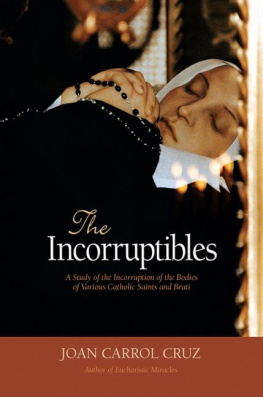Joan Carroll Cruz - Relics: What They Are and Why They Matter
Here you can read online Joan Carroll Cruz - Relics: What They Are and Why They Matter full text of the book (entire story) in english for free. Download pdf and epub, get meaning, cover and reviews about this ebook. year: 2015, publisher: TAN Books, genre: Religion. Description of the work, (preface) as well as reviews are available. Best literature library LitArk.com created for fans of good reading and offers a wide selection of genres:
Romance novel
Science fiction
Adventure
Detective
Science
History
Home and family
Prose
Art
Politics
Computer
Non-fiction
Religion
Business
Children
Humor
Choose a favorite category and find really read worthwhile books. Enjoy immersion in the world of imagination, feel the emotions of the characters or learn something new for yourself, make an fascinating discovery.

- Book:Relics: What They Are and Why They Matter
- Author:
- Publisher:TAN Books
- Genre:
- Year:2015
- Rating:5 / 5
- Favourites:Add to favourites
- Your mark:
- 100
- 1
- 2
- 3
- 4
- 5
Relics: What They Are and Why They Matter: summary, description and annotation
We offer to read an annotation, description, summary or preface (depends on what the author of the book "Relics: What They Are and Why They Matter" wrote himself). If you haven't found the necessary information about the book — write in the comments, we will try to find it.
Relics: What They Are and Why They Matter — read online for free the complete book (whole text) full work
Below is the text of the book, divided by pages. System saving the place of the last page read, allows you to conveniently read the book "Relics: What They Are and Why They Matter" online for free, without having to search again every time where you left off. Put a bookmark, and you can go to the page where you finished reading at any time.
Font size:
Interval:
Bookmark:
What They Are and
Why They Matter
JOAN CARROLL CRUZ
TAN Books
Charlotte, North Carolina
Nihil Obstat:
Rev. John H. Miller, C.S.C.
Censor Librorum
Imprimatur: Archbishop Philip M. Hannan, D.D.
Archbishop Philip M. Hannan, D.D.
Archbishop of New Orleans
July 4, 1983
TAN edition copyright 2015 TAN Books.
The TAN edition has been re-typeset, with revisions, using the edition first published in 1984 by Our Sunday Visitor, Huntington, Indiana. Revisions include updating of punctuation, and spelling, along with the correction of occasional errors in typography, spelling, grammar, syntax, diction, and factual information.
All rights reserved. With the exception of short excerpts used in articles and critical review, no part of this work may be reproduced, transmitted, or stored in any form whatsoever, without the prior written permission of the publisher.
All scriptural quotations appearing in this work have been quoted or paraphrased from various editions of the Bible, including the Revised Standard Version and Douay-Rheims.
Cover design by David Ferris.
www.davidferrisdesign.com
Cover images courtesy of St. John Cantius Church, Chicago, IL.
Cataloging-in-Publication data on file with the Library of Congress.
ISBN: 978-0-89555-859-6
Printed in the United States of America.
TAN Books
Charlotte, North Carolina
www.TANBooks.com
2015
Once again I am overwhelmingly indebted to Serena Bodellini Burke for assisting with the translation of Italian and French research material. I am likewise indebted to my brother, Daniel Carroll, for his help in editing this work. Gratitude is also extended to my husband and children for their help and patience during the five years I was occupied with this project.
As with a previous work, I relied heavily upon information gathered from European shrines, churches, monasteries and convents. The clergy and religious in eighteen countries who kindly answered my queries are quite numerous. Their thoughtfulness and generosity in supplying books, pamphlets, magazines, papers, and photographs proved invaluable to the research of this volume. Should I attempt to mention all my correspondents I would be afraid of unintentionally omitting a single name, therefore, I am taking this means to express to all of them my profound respect and deepest, heartfelt appreciation.
Joan Carroll Cruz
For my dear husband, Louis,
my children Tommy, Mike,
Jeannine, Carolyn, Louis,
and his wife June,
for their patience, understanding
helpfulness, and love.
_______________
The veneration of relics is practiced by Christians and non-Christians alike. It is in no way restricted to the Catholic religion, but is, to some extent, a primitive instinct with origins that predate Christianity.
It is known, for instance, that relics of Buddha, who died in 483 B.C., were distributed soon after his death. Although there remain only a limited number of authentic relics, parts of his body, including teeth and hairs, have been carefully preserved and enshrined in various domed, towerlike shrines that are found in cities and in the countryside throughout the Buddhist world. Known as stupas, or pagodas, these shrines are visited by both monks and laymen who walk around them in a practice known as circumambulation, making offerings of food and flowers while meditating on the doctrines taught by Buddha. Since there are only a few authentic relics, some of the millions of stupas in Asia contain only images, prayers or sacred writings as reminders of the prophet. The extreme development of relic worship among the Buddhists of every sect is a fact beyond dispute.
The relics of Confucius have been venerated every year by Chinese and Asian peoples since the year 195 B.C. when Emperor Kao Tsu of the Han Dynasty visited the tomb and offered sacrifices. Although Confucius laid no claim to being more than a man, his system of ethics gradually assumed the aspects of a religious cult. His analects are wise sayings similar to the Proverbs in the Bible. In accordance with tradition there are no statues or images of the sage, only tablets inscribed with his name. The followers of his teachings number more than 300 million, with many paying homage at his tomb.
Relics of Mohammed, who died in A.D. 632, are likewise revered, these being two hairs of the prophet which are kept in a reliquary resembling a domed temple that stands several feet high beside the huge rock in a building in Jerusalem called the Dome of the Rock. This limestone rock, measuring 58 feet by 44 feet, figures in Islamic, Jewish, and Christian traditions and is something of a relic itself, being regarded by Moslems as the rock visited by an angel before the creation of Adam and Eve and the place where Mohammed ascended to heaven. Here Abraham is said to have nearly sacrificed his son, and it is claimed that all the great prophets from Elijah onward prayed beside it. Many Christian churches profess the belief that Christ will descend on the spot at the Second Coming.
Since the early days of the Church the remains of a saint or holy person were called relics, from the Latin Reliquiae meaning remains. Relics are divided into three categories. First-class relics are parts of the bodies of saints and the instruments of Our Lords Passion. Second-class relics are objects sanctified by close contact with saints, such as articles of clothing, objects used in life or, in the case of a martyr, the instruments of his torture. Third-class relics are objects or cloths touched to either first- or second-class relics.
Material benefits obtained through relics of saints have often included miracles, as is witnessed not only by the history of the Church and the lives of the saints, but also by Sacred Scripture. In the Old Testament the relics of the prophet Elisha are mentioned. It is related that:
Elisha died and was buried. At the time bands of Moabites used to raid the land each year. Once some people were burying a man when suddenly they spied such a raiding band. They cast the dead man into the grave of the prophet Elisha, and everyone hurried off. But when the man came in contact with the bones of Elisha, he came back to life and rose to his feet (2 Kings 13:20-21).
The New Testament mentions second-class relics of the Apostle Paul and the wonders the Lord worked through them. The Acts of the Apostles relate that:
God worked extraordinary miracles at the hands of Paul. When handkerchiefs or cloths which had touched his skin were applied to the sick, their diseases were cured and evil spirits departed from them (Acts 19:11-12).
Other cloths known as branded, after lying for a time in contact with the remains of the holy apostles, were likewise treated as relics.
After the apostolic times, the earliest record of honor paid relics of holy persons was written by the inhabitants of Smyrna about A.D. 156 which described the death of St. Polycarp. After the saint had been burned at the stake, we are told that his faithful disciple, after encountering delays by Roman officers:
took up his bones which are more valuable than precious stones and finer than refined gold, and laid them in a suitable place where the Lord will permit us to gather ourselves together in gladness and joy and to celebrate the birthday of his martyrdom.
The authenticity of this passio is beyond question, since it has been proven that it was written soon after Polycarps martyrdom in the year 156 or 157.
We learn three times from St. Cyril of Jerusalem (d. 386) that relics of the wood of the cross, discovered about the year 318, were already distributed throughout the world. St. Gregory of Nyssa (d. c. 400), in writing about the forty martyrs, described how their bodies were burned by persecutors and recorded that:
Font size:
Interval:
Bookmark:
Similar books «Relics: What They Are and Why They Matter»
Look at similar books to Relics: What They Are and Why They Matter. We have selected literature similar in name and meaning in the hope of providing readers with more options to find new, interesting, not yet read works.
Discussion, reviews of the book Relics: What They Are and Why They Matter and just readers' own opinions. Leave your comments, write what you think about the work, its meaning or the main characters. Specify what exactly you liked and what you didn't like, and why you think so.




